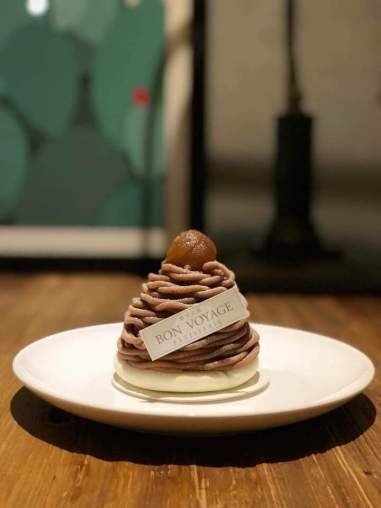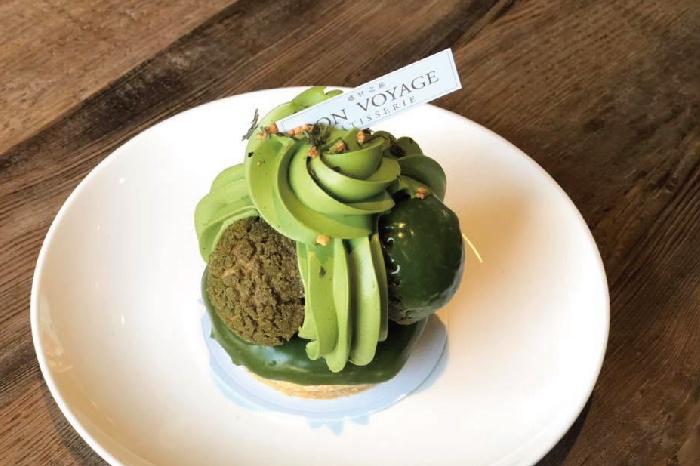一場由文學 美學 料理開啟的感官之旅| Bon Voyage Pâtisserie 感官之旅
文/黃書萍 照片提供/感官之旅
Facebook:感官之旅
500彰化縣彰化市自強路102號
子揚與宏辰是感官之旅糕點師,一位創意發想、一位精準味蕾,一位小心謹慎、一位大膽嘗試,訪談的這天兩位熱情的迎接,爭相準備當日下午好茶,一位說著好茶的由來,一位說著泡茶從來不是他的工作,這樣相輔又帶著拌嘴的兩人,說起甜點更是滔滔不絕….


如果心中種下一株苗 有朝一日會成一棵樹
當初會踏入甜點這行業,對於非科班出生完全是素人的我憧憬的無非是想完成大學時期畢業專題的想像,在當時以三島由紀夫為專題核心,探討文學與美學的關聯,那時候心裡不斷想著,文學、美學,若加上料理,是不是更能呈現這三者撞擊出的感受。
大學畢業後也就一頭栽入甜點世界
如果說:做甜點是因為喜歡甜點,倒不如說,甜點背後的故事更是令人感到迷人、深邃。在還沒正式進入學習場域前,那陣子台灣非常瘋迷馬卡龍,就前往台南某知名店家品嘗–馬卡龍,第一次吃到他是扎實帶硬的口感、內餡沒有獨特的風味,就疑惑為何不是大家傳說外酥內軟有如「少女的酥胸」,也就開啟我去找尋馬卡龍的真實滋味,並且翻閱更多馬卡龍的歷史,發現法國早在西元781年就有製作的紀錄,經過時間與歷史的交會至西元1547年義大利梅地奇家族(Catherine de Médicis)與法國公爵的聯姻,更是將義大利甜點作法帶入法國,而至今只要是以杏仁粉、蛋白、糖三元素所做的都泛指馬卡龍,然而單一一款甜點,現今在法國包含南錫、普羅旺斯、巴黎各有獨特做法,看到這些豐富的歷史典故,讓我對法式甜點更是著迷,不得不栽入這個法式甜點世界。
一路跌跌撞撞 才打開了感官之旅
剛開始進入甜點店從學徒做起,爾後也走進飯店、麵包店、中央廚房…等地方學習甜點,但從初期的學習都沒有打算開自己的甜點店,直到2013年宏辰開始在家裡照顧生病的爸爸,那時候他獨自買器材、烤箱,試著以私人工作室銷售甜點,隨後我也加入工作室的工作型態,一起建立感官之旅的品牌形象、包裝、產品,就這樣兩年的時間,在網路世界追求曝光度、點擊率,也與合購網合作依附團購主的喜好,不論宅配、市區面交都同時進行,忙碌卻難以累積,收入更是難以支撐想做的事,就在幾度放棄邊緣,也思考是否還有其他路徑,就在2014年開始與藍廚義式廚房合作甜點寄售,那段時間的合作也讓自己理解,甜點的故事、味蕾的感受,不是寄售型式、餐後甜點能完整呈現自己的甜點。
因此,開一間屬於自己的甜點店,說出自己的故事、傳遞甜點的完整體驗,是開店才能做的事。
甜點的滋味 就好比一首奏鳴曲
法式甜點就好比一本經典,然而經典裡的每一道菜譜都是一首曲子,是富有層次、是多感體驗的,包含耳朵、鼻子、口腔、舌頭、與心的感受。這樣的感受就好比店內其一款蛋糕「青澀」,我們以香檳、青蘋果、青芒果、甜薄荷、荷蘭薄荷,五種不同層次的「青」進入蛋糕,以跳跳糖酥餅為底,其上鋪上杏仁蛋糕、芒果青與薄荷、青蘋果組成的果凍、再加上法式蛋糕必備的慕斯,一層為青蘋果慕斯、一層為香檳慕斯,如此多層次但不互相搶味,讓大家在吃的感受上,享受五感的滋味,並以青澀命名,讓人猶如回到每個人心中最初的愛。
一款甜點的研發也常常需要花上半年,從食材的季節性、食材之間的平衡、口感、香氣、視覺,一直到店內員工試吃大會,往往試做到上架需要2、30次的調整,過程間也會因為各種感受的交疊,為他找尋最適切的名子,如此一首曲子才算完成。
甜點的旅程 不僅是食譜 更是心法
初期在亞森甜點店擔任學徒,當時除了製做甜點,更重要是吃甜點,主廚阿洸師傅常常提醒我們「吃到什麼」、「吃的感受」,如果我們只會說出好吃、不好吃,卻無法談到好吃在哪、不好吃又在哪,那這樣的學習只是停留在食譜上。有一回當我吃到甜點大師Pierre Herme經典之作「玫瑰‧荔枝‧覆盆子」磅蛋糕,大師將看似無關聯的食材,找出其共同關聯性,讓玫瑰的香、荔枝獨有的酸香感、覆盆子的酸,彼此共處,創造獨特的大師食譜,如此大膽的作法,令後輩學習的我們,看到甜點這條路,就是要不斷用打開心創造自己的感官之旅。



訪談後 白色方塊也想說
訪談過程聽著子揚說甜點,就好比沉醉在一場美好的音樂會,說著法式甜點的起源,歷史書上那些戰事、兩邦兩國聯姻,背後是促成甜點的交流與技術革新,這些深刻而精采的故事,是品嚐甜點時更顯滋味,也是讓我們反思歷史、文化的傳遞是累積,更是這代人面對生活更需珍視之處。

A journey of senses composed of literature, aesthetics and culinary passion
Interviewee/ Zhiyang and Hongchen, pâtissiers of Bon Voyage Pâtisserie Interviewer and Editor/ Daniella
Zhiyang and Hongchen are Bon Voyage Pâtisserie’s pâtissiers. They are an interesting combination of varying characteristics: creativity, absolute tastebuds, discretion and boldness. The day this interview took place, they eagerly prepared for an exquisite afternoon tea, one explaining the origin of the tea while the other joked about his lack of knowledge in the field. Such conflicting dynamic is in fact how they support each other. And when it comes to dessert, they simply couldn’t stop sharing.
An idea seeded will someday grow to harvest
My academic background has nothing to do with desserts. I entered the field with an intention to fulfill the vision I had in my senior project in university. Back when I was studying the correlation between literature and aesthetic based on Mishima Yukio’s works, I constantly came across this idea to incorporate food into the relation and see what effects it could have.
Embracing the world of desserts after university graduation
Instead of articulating my passion for dessert being the cause of my choice of career, it’s rather more about me being fascinated by the stories behind each dessert. Before I officially started out as a pastry chef, people in Taiwan were really crazy about macarons at the time. Hence, I went to a renowned pastry shop in Tainan and tried macaron for the very first time. The one I had was crispy and solid, and the filling was plain. I wondered why it didn’t match up with how people described it, so I started looking into macarons. I found its earliest record in France in the year 781. The Italian recipe and techniques were brought to France in 1547 upon French Queen Catherine’ de Médicis marriage to Henry II of France. Today, macarons generally refer to pastries made with almond power, egg white and sugar. Variations in France alone are ample. The abundant history to French desserts is really enchanting to me.
Struggling along the way to finally starting Bon Voyage
Pâtisserie
I started as an apprentice, and then worked in hotels, bakery, central kitchen, etc. At first, I had never thought about opening a pastry shop of my own. Later in 2013, as Hongchen had to take care of his dad at home, he started purchasing equipments to run a private dessert studio. It was then I joined the studio, Bon Voyage Pâtisserie, establishing a brand image, designing packaging and products. For the next two years, we worked really hard in online sales as well as meet-up deliveries. We realized that though we were extremely busy, the business was not growing. With insufficient income to sustain, there were many times we almost gave up. Meanwhile, we also started considering other ways out. Then, we collaborated with Blue Cook, selling our desserts in the Italian restaurant in 2014, which helped us realized that in order to fully present the stories and tastes of our desserts, we need to do more than just selling our desserts somewhere. Hence, we came to the conclusion that telling our own stories and presenting a comprehensive dessert experience can only be done by opening a pâtisserie of our own.
The taste of a dessert is like a sonata
French desserts are like a collection of musical classics. Every recipe is a composition consisting of layers and multiple senses that engage your ears, nose, mouth, tongue and heart. Take “Green” for example. It is a cake made with five elements of green including champagne, green apple, sweet citrus mint and spearmint. With shortbread added with pop rocks as base, “Green” is layered with almond cake and jello made with sour mango, mint and green apple. On top of the three tiers is mousse, an essential element of French desserts. The mousse consists of a green apple flavored layer and a champagne flavored layer. All the layers compliment one another perfectly without stealing the show.
It usually takes at least six months to develop a new product. Factors like the season of food ingredients, balance, texture, aroma and visual presentation must all be taken into account. In the final phase of our product development, we usually get all our staff to taste the new product that has been modified 20 to 30 times. During the process, we came up with the name that best fits according to the senses and feelings we have picked up along the way. This is how we finalize a composition.
Desserts are based on not only recipes but also mentality
At the beginning of my career at Arsen Pâtisserie as an apprentice, a major part of my job was also to taste desserts. Chef was always reminding me to clearly articulate what I had tasted as well as specific feelings triggered by the tastes. If an apprentice could only make statements like “It’s delicious”, or “It’s not tasty” but unable to articulate the reasoning, his learning will be confined to merely recipes. Once, I tasted Master Pierre
Herme’s classic “rose, lychee and raspberry pound cake”. I was in awe of the technique he used in linking the seemingly irrelevant ingredients. The kind of boldness is what inspires me to constantly be open-minded and proceed on my own journey of senses.




